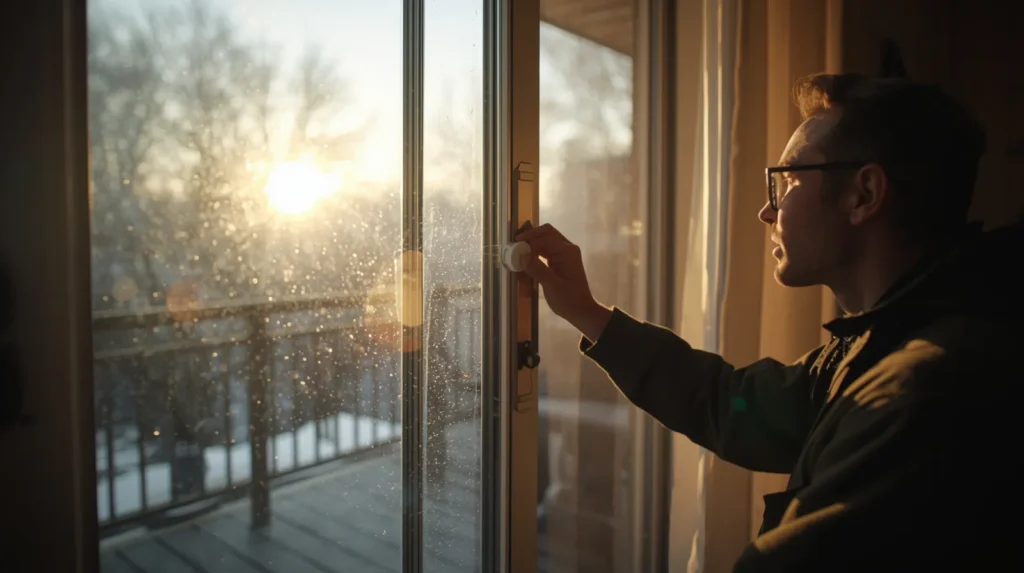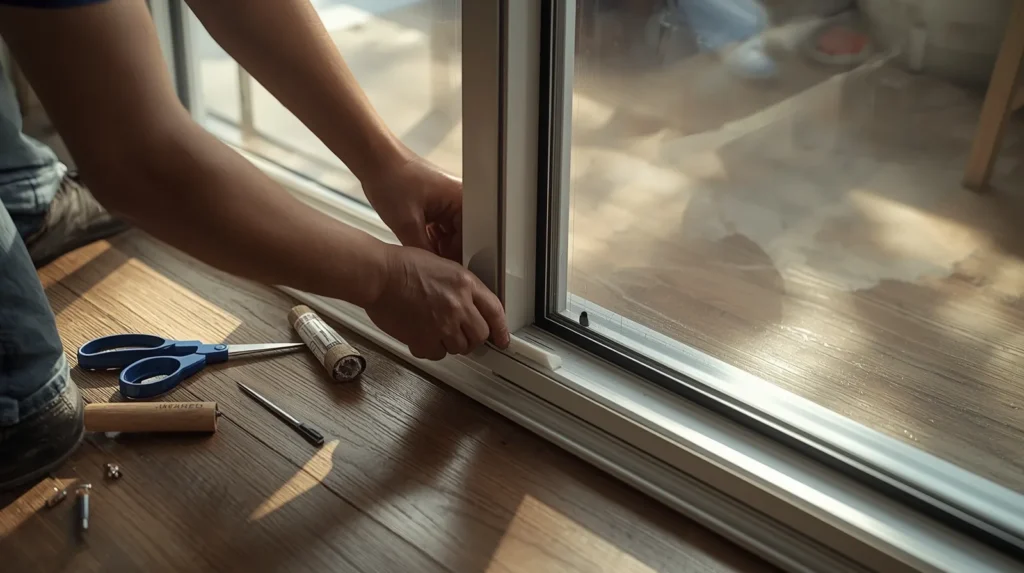Sliding glass doors look beautiful and brighten your home, but when cold weather arrives, they often become the biggest source of heat loss. Many homeowners wonder how to insulate sliding glass doors for winter without spending too much. The answer is simple. You can keep the warmth inside by sealing gaps, adding weather stripping, and using insulation film. These easy steps improve comfort, reduce heating bills, and protect your home from cold drafts. In this guide, you’ll learn practical ways to winterize your doors, seal air leaks, and create a cozy home that feels warm all season long.
Why Sliding Glass Doors Lose Heat in Cold Weather
Sliding glass doors have large glass panels that let in light but also let warmth escape. Unlike insulated walls, glass conducts heat easily. In winter, the warm indoor air touches the cold glass, and energy slips away. Even a tiny gap between the panels or around the frame can let cold air sneak in.
Metal frames, common in older doors, can also carry cold straight into the room. Over time, the seals may wear out, and the door can shift slightly from frequent use. This combination of air gaps and cold surfaces makes the space near your sliding door feel chilly. Understanding this helps you know exactly why insulation matters before winter hits.
The Importance of Winterizing Your Sliding Doors

Winterizing is not only about comfort, it’s also about saving energy and money. When your sliding glass door is poorly insulated, your heater works harder to keep your house warm. That means higher energy bills and unnecessary wear on your heating system.
Proper insulation also prevents condensation from forming on the glass. Moisture can cause mold, mildew, and even damage to wooden frames or flooring. By winterizing sliding doors early in the season, you keep your home safe, warm, and efficient. Homeowners who take this small step often notice that rooms stay evenly heated, and drafts disappear completely.
How to Insulate Sliding Glass Doors for Winter
Here’s the direct answer to our main question: the best way to insulate sliding glass doors for winter is by sealing air leaks and adding thermal barriers. You can start with weather stripping, plastic insulation film, and a draft stopper at the bottom.
If your door has cracks around the edges, use caulk for sliding glass door frames to close them. For older doors, consider an insulating curtain or a thermal drape. These fabrics trap warm air inside and block cold air from reaching the room. You can also add insulating panels or temporary foam boards for extra protection during extreme cold.
By mixing these simple methods, you’ll see a major difference in both warmth and comfort.
Simple Ways to Seal a Sliding Glass Door

Sealing your door starts with a close inspection. Open and close the sliding panels slowly while checking for any light or air coming through. If you feel a draft, mark the area. Then, clean the door track and remove any dirt or debris. Dust or buildup can prevent the door from closing tightly.
Next, apply weather stripping on the sliding glass door frame. Foam tape or silicone strips work best for small gaps. For larger ones, choose rubber seals. Make sure the door glides smoothly after installation.
If cold air still slips in, you can also use caulk along the outer edges where the door frame meets the wall. This stops outside air from entering and gives you an airtight seal for the winter.
Using Weather Stripping to Stop Drafts
Weather stripping is one of the most effective ways to block heat loss. It’s affordable, quick to install, and easy to maintain.
Start by measuring the length of your door frame. Cut your chosen weather strip to match it. Peel off the backing and press the adhesive side firmly into place. When the door closes, it should feel snug but not too tight.
Different materials offer different benefits. Foam is flexible and perfect for uneven edges. Silicone lasts longer and handles temperature changes well. Rubber provides a tight, durable seal. These materials all work great for sliding glass door weather stripping and can dramatically reduce drafts during cold months.
How to Winterize a Sliding Glass Door Properly
Winterizing is more than just sealing; it’s about preparing the entire door system for the season. First, clean the glass and track thoroughly. Dust and dirt can prevent seals from sticking. Next, check the rollers. If they’re worn or uneven, replace them so the door closes tightly.
Install new weather stripping if needed, then add a draft stopper for sliding glass door at the bottom edge. This long, padded piece blocks air from entering under the door. If you have sliding screens, remove them for winter to create a tighter fit.
Finally, add a layer of plastic for sliding glass door insulation film. This clear material adds an invisible thermal barrier that traps warmth inside. It’s a simple DIY fix with powerful results.
The Role of Plastic Film and Door Insulation Kits
Plastic insulation kits are perfect for anyone who wants quick results. You can find them at most hardware stores. These kits include clear film and double-sided tape. After cleaning the door frame, apply the tape, stretch the plastic film across it, and heat it lightly with a hairdryer. The plastic will tighten and create a smooth, see-through layer that blocks cold air.
Using plastic for sliding glass doors helps reduce condensation while keeping your view clear. It’s an inexpensive fix that often lasts through the entire season. Combined with good weather stripping, this solution can make your door feel nearly as warm as a solid wall.
Installing a Draft Stopper for Extra Protection
A draft stopper is one of the easiest upgrades you can make. It’s a fabric or rubber piece placed at the base of your sliding door. Its main job is to block cold air from creeping in through the bottom gap.
There are two main types: removable stoppers that you slide into place and fixed ones that attach permanently. The removable version is great if you only need it during winter. If your home stays drafty year-round, a fixed stopper gives better long-term insulation.
Pairing a draft stopper for sliding glass door with weather stripping adds an extra layer of warmth, keeping your floors comfortable and your heating costs lower.
Caulking and Weatherproofing Around the Frame

Even small gaps around your door frame can leak heat fast. Use caulk for sliding glass door edges where the frame meets the wall. Silicone or acrylic latex caulk works best because it’s flexible and can handle temperature changes.
Before applying, clean the area well. Then, run a smooth bead of caulk and flatten it gently with a damp finger. Allow it to dry for 24 hours.
In addition to caulking, you can install door sweeps or foam inserts to improve the seal. This step is essential for complete weatherproofing sliding glass door frames. Once done, your door will be well protected from wind, moisture, and freezing air.
How to Insulate Patio and French Doors
Sliding doors aren’t the only ones that need attention. Patio and French doors can lose just as much heat if not sealed properly. The process is almost the same.
Start by checking for gaps and cleaning the surfaces. Add weather stripping, draft stoppers, and use plastic film insulation if necessary. For French doors, focus on the area where the two doors meet in the middle, as this is a common leak point.
When you insulate patio door for winter, you’ll also improve comfort in nearby rooms. Whether it’s wood, vinyl, or metal, every frame type benefits from better sealing and insulation.
Professional Help from Texas Windows in Lewisville, TX
Sometimes, DIY methods may not solve major drafts or older frame issues. In those cases, calling a professional makes sense.
Texas Windows offers expert inspection, sealing, and repair services that ensure your doors are fully winter-ready. Their team understands the small details that make a big difference, like adjusting rollers, tightening frames, and applying premium-grade insulation materials.
Whether you have patio doors, French doors, or sliding glass models, Texas Windows provides solutions that balance function and appearance. A properly insulated door not only saves money but also keeps your home peaceful, warm, and welcoming during cold months.
Conclusion
Insulating your sliding glass doors for winter is one of the smartest steps you can take for home comfort and energy savings. The process doesn’t require expensive materials or expert tools. Start with weather stripping, caulking, and plastic insulation film. Add a draft stopper and tighten any loose parts.
Doing these things can make your home feel warmer right away and protect it from cold winds and moisture. The result is a cozier living space and lower energy bills throughout the season. A well-insulated door also adds value to your property by improving energy efficiency and reducing wear on your heating system.
Reach out to the friendly experts at Texas Windows today for a professional door insulation checkup. Enjoy peace of mind knowing your home will stay warm, comfortable, and energy-efficient all winter long.



